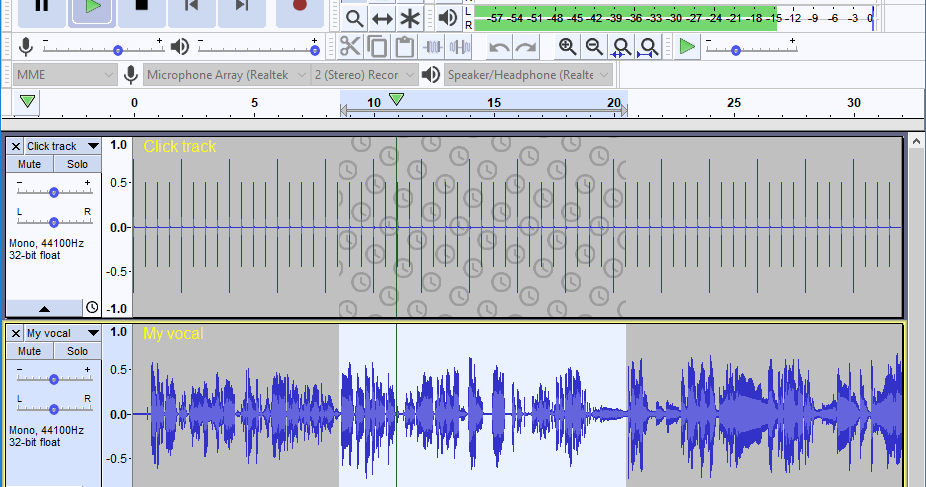

You can add multiple points to further shape the necessary change.

As the actual sound wave isn’t changed, the source file will remain untouched. The Envelope Tool will allow you to change the volume of any track without actually changing the amplitude. One way to easily do it requires the use of the Envelope Tool. Making high or low crossfades isn’t automated in Audacity. You can either use the time shift tool to bring it back to where it needs to be, or better yet, just convert the first part of the track to silence. Be careful with the track that you’re fading in, though, as deleting it will move it back to the beginning. You can delete the rest of the first track if you’re done with it. Then, in the next track, select the portion you want to fade in. When you’re lined up, select a portion of the track you want to fade out. Align the two tracks you want to crossfade in the timeline, either by editing or by using the time shift tool. In Audacity, it’s easy to add linear crossfades. In crossfades, if you want to mess with the rate of change of volume, you need to more aggressively change it. In fact, our ears have a sensitivity from 1 to 130 decibels, which is to say that the loudest sound you can hear is roughly 10 trillion times loader than the softest sound you can hear! As such, what appears to be a “linear” change in volume is actually logarithmic. Just like how we can hear very low frequencies (like 20 Hz) and very high frequencies (like 20,000 Hz), we can hear very soft sound and very loud sounds. Human hearing is very sensitive to acute changes in sound. Sound is measured in Bels, or more commonly, as fraction of that unit: decibels. Low-level crossfades are below half volume halfway through the transition, and high-level crossfades are above half-volume halfway through the transition. For mid-level crossfades, at halfway through the transition the volume of each track is half. When the two tracks crossover, their volume builds. The effect feels almost like a lull (but lacking complete silence) and the volume then builds up quickly again after, almost like a swoop. For the duration of the fade, both tracks have a reduced volume until the original track is almost completely gone.
How to make audio loopback in audacity download#
You can download a short sample track here: low crossfade. The fade-in track starts gaining volume slowly but it picks up speed as time goes on. Low: The faded-out track drops its volume pretty quickly and the speed of this drop slows down over a period of time. The volume changes look like bulges here, with the effect that the both tracks have a high volume through the duration of the fade, and there is still some abruptness to it. You can download a short sample track here: high crossfade. The faded-in track, on the other hand, picks up volume fairly quickly and that increase of volume slows down over a period of time. High: The faded-out track starts fading slowly, then picks up speed as time goes on. Depending on the volume of the original tracks, this sounds more or less even. You can see that the volume increase/decrease looks steady.

You can download a short sample track here: mid crossfade. You can group crossfades into three vague categories, and each sounds very different from the others. DJs often use this technique while matching beats of two different songs to produce a continuum of sound, while editors often use crossfades (as well as fade-ins and fade-outs) to make the introductions of different sound components sound less “sudden” and more natural. Crossfading is valuable because it allows these changes to happen quickly without being jarring, without introducing silence, and while sounding smooth and more natural. The same goes for video it’s useful to be able to fade in to a crowd’s cheer, or fade out of an original audio source in favor of narration of some kind. Many songs use fading techniques to great effect when starting or ending, or at particular parts in the song. It usually sounds like you opened the door to another room with different music, then went through it and closed the door behind you. The first track slowly fades out and the second fades in, but instead of there being silence in between, it happens concurrently. This is what a fade-out looks like visually:Ī crossfade is essentially doing both simultaneously to two separate tracks. Sharper fades happen quickly while duller or steadier fades take a long time. When an audio track starts with silence and the volume rises up out of nowhere, that’s called a “fade-in.” When a track slowly lowers its volume until it’s nothing but silence, it’s called a “fade-out.” How “sharp” a fade is directly involves how much volume is lost or gained over what period of time. Odds are you know what a fade is, though maybe not by name.


 0 kommentar(er)
0 kommentar(er)
